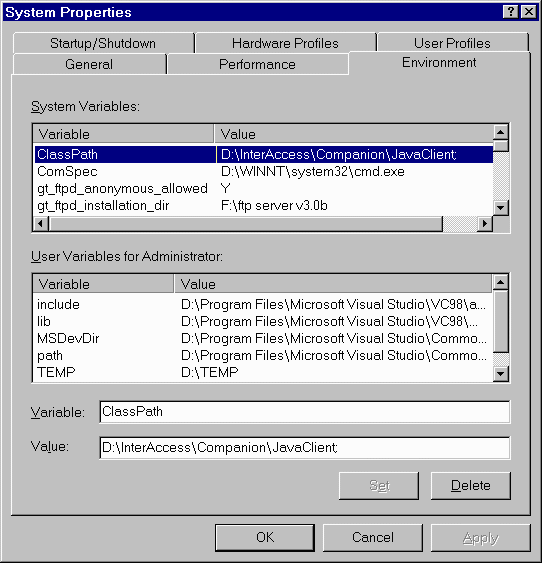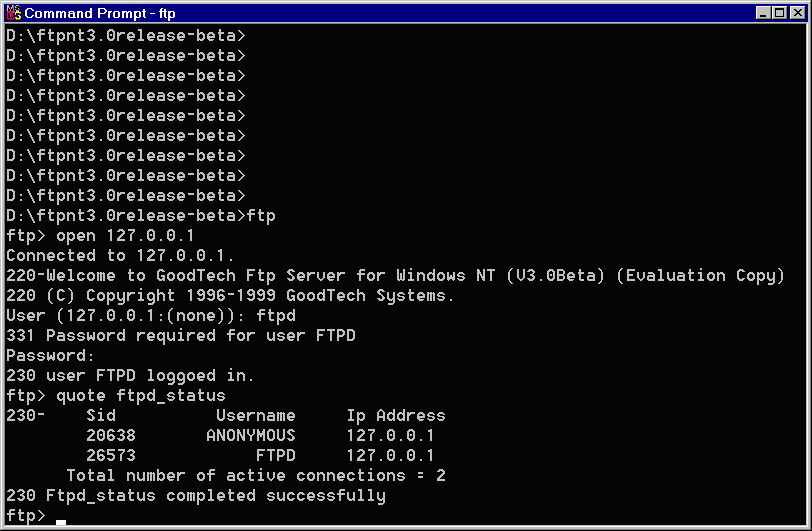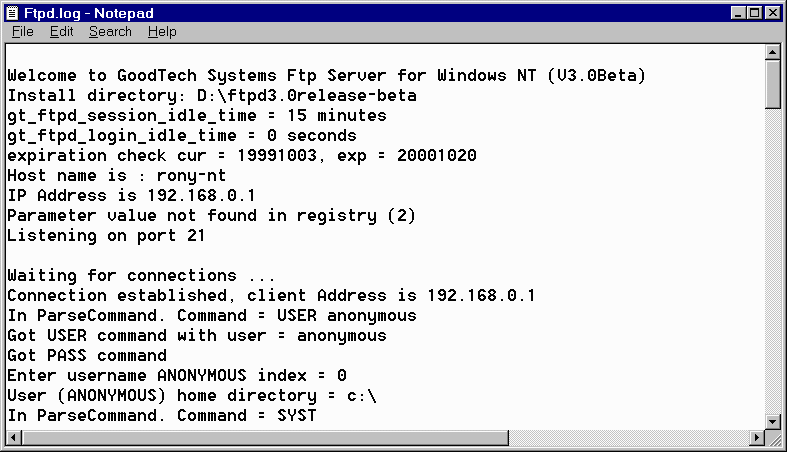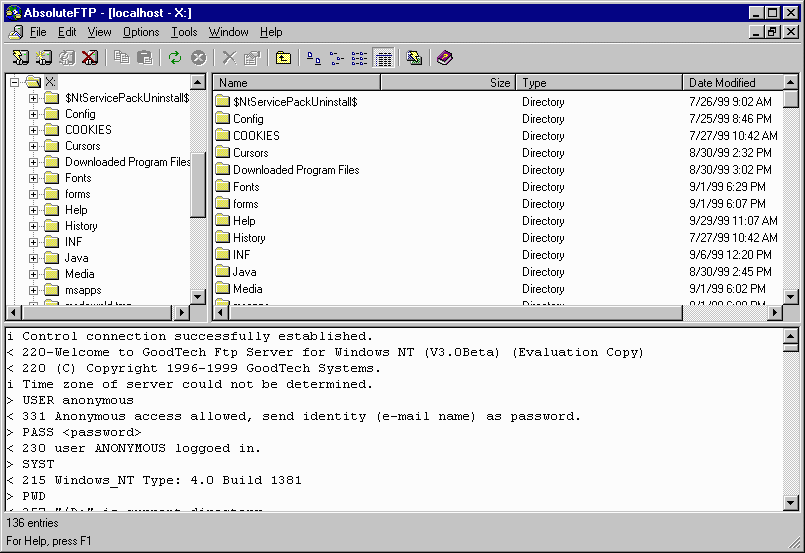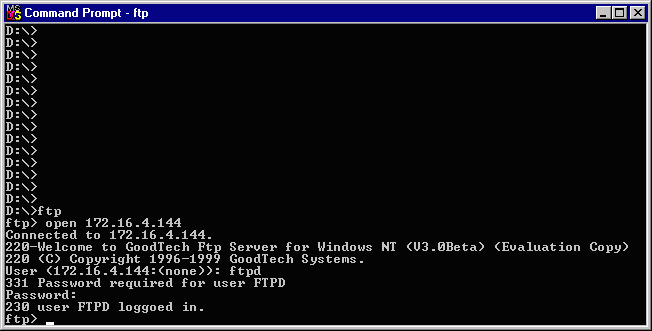GoodTech FTP Server for Windows NT/2000/XP/2003 Introduction to GoodTech Ftp Server How the GoodTech Ftp Server Works Installing GoodTech Ftp Server Configuring the GoodTech Ftp Server Administrating the GoodTech Ftp Server Controlling the GoodTech Ftp Server Service Starting the GoodTech Ftp Server Service Stopping the GoodTech Ftp Server Service Working with GoodTech Ftp Server
Screen Shots Screen Shot 2 – Windows NT System Properties, Setting Environment Variables Screen Shot 3 – The Command "ftpd status" Screen Shot 4 – The ftpd Log File Screen Shot 7- Using FTP in Netscape This help document gives you an introduction to ftp and to our Ftp Server, describes how to install, set up and use the ftp server, and has a trouble shooting chapter to help you overcome problems. We hope you will find it helpful. Although we did our best to proofread this help, we are unfortunately not immune to mistakes and omissions. If you find any mistake or have suggestions to improve this help, please let us know. Ftp (File Transfer Protocol) is a set of commands of how comupters might share files over the Internet/inranet. Due to the design of the protocol, different machines, using different operating systems and different hardware, can exchange files efficiantly in a safe manner. The FTP protocol require two programs, a server program, and a client program. Normally the server program offer files to the client program. But in some cases, the server will also allow the client to upload files. Ftp server is a server application that runs on a host computer and allows remote users to transfer files between the clinet and the host machine. Ftp client is a client application that allows a user to communicate with the ftp server and transfer/receive files over the network. Introduction to GoodTech Ftp Server GoodTech Ftp Server for Windows NT is an ftp server application that runs on a host computer and allows remote users to Ftp in to the host. Microsoft Windows NT networking has a built-in Ftp client, but does not have a built-in Ftp server, so Goodtech Ftp Server can be used to provide the missing build-in Ftp Server functionality. When Goodtech Ftp Server is installed on your Windows NT system, you can Ftp from remote systems and exchange files to/from your Windows NT system. It is a functional, easy to use and high performance tool, that is written based on open standards (RFC 959), can communicate with any standard ftp client and is highly integrated with Windows NT operating system. By using an Ftp client, you can connect to GoodTech Ftp Server from anywhere in the world and send/receive files to/from the Windows NT system. Whether you are a system administrator, a programmer or a DOS application user, GoodTech ftp server can provide you with the Ftp Server functionality that you need. How the GoodTech Ftp Server Works The installation program creates a ftp service called ftpd and adds it to the list of services available on your NT system. When the Ftp Server service is started, either manually or automatically, it executes a program named ftpd.exe. The program ftpd.exe opens a log file ftpd.log in the %gt_ftpd_installation_dir% directory.(were gt_ftpd_installation_dir is the system environment variable created during installation, that contains the GoodTech Ftp Server installation directory) Ftpd.exe is now ready for connection requests. It listens to requests on the default ftp port (#21) or on other port if a different port was specified when the ftp service was started. When a user wants to ftp out to the host running GoodTech ftp server, he runs an ftp client program. The ftp client program sends a connection request to port #21 (or to any other port the ftp server was configured to listen). The ftpd.exe program gets the request and opens a thread, which is responsible for this connection with the client. This thread relieves ftpd.exe from communicating with the client and let ftpd.exe focus on listening to other connection requests. The client thread starts the authentication process. It asks the ftp client for login information. The login information consists of a User ID and Password. The client thread then uses the internal NT security mechanism to check if the user is allowed to the host. If the user passes authentication, he is logged onto the host system, and is now ready to work on the host. GoodTech Ftp Server Key Features
Registration is very simple - you are automatically registered when you order from GoodTech Systems. When we receive your order, we will send you back your registration number along with your registered copy of the product. Our simple licensing policy lets you purchase as many copies as you need and get a single license for all copies. Installing GoodTech Ftp Server GoodTech Ftp Server is supported on Windows NT 4.0/2000/XP/2003. The TCP/IP protocol must be installed on your Windows NT system. This protocol is included with the Windows NT operating system but is not always installed on all systems. You can check if TCP/IP is installed on your system by choosing Network from the Control Panel. If TCP/IP is installed on your system it should show up in the list of Installed Network Software. You should use the Administrator account or any other account with administration priveleges to install the GoodTech FTP Server service. Make sure that all users have READ/WRITE/EXECUTE permissions to the Ftp Server installation directory, and READ permission to the SYSTEM32 directory. (e.g. C:WINNT\SYSTEM32). Please note that you can change the permissions to the executable files in the FTP Server installation directory to READ only. Running the Installation Program After downloading the evaluation copy of the GoodTech Ftp Server or receiving the registered copy, run the ftpdSetup.exe program. The installation creates a system environment variable called gt_ftpd_installation_dir that contains the GoodTech Ftp Server installation directory. Note: The FTP server service starts automatically every time you reboot your machine.
ftpdSetup.exe /S /D=<Ftp Server installation directory> If you want to install a new version of the Ftp Server but have a previous version currently on your system, you have to do the following:
If you want to uninstall the GoodTech Ftp Server from your system, choose one option from the following options:
Please note that silent uninstall is also supported by issuing the following command from a command prompt: (From your Ftp Server installation directory) uninst.exe /S Configuring the GoodTech Ftp Server Creating and Configuring Accounts Using Windows NT User Accounts When a Ftp user logs in to your system via GoodTech Ftp Server, he must be a valid user that was created by the Windows NT network administrator, using the Windows NT User Manager. GoodTech Ftp Server sets a user's process to run in the security context appropriate to that user. The user then has exactly the same privileges he would have on the ftp host machine as if he sat down in front of it and logged in on the console. GoodTech FTP Server looks for a configuration file named config.dat in the the FTP Server installation directory. If the file exists it reads the configuration parameters inside it. For example to change the default listening port for FTP Server (default is 21), you can put the line FTPD_PORT=31 in this file, and after restarting the FTP Server service the listening port will be 31. Please that you should restart the FTP Server service on any modification to the config.dat file. Each parameter in the file should be on a separate line, and have the following syntax: PARAMETER-NAME=PARAMETER-VALUE The GoodTech FTP server, supports the Anonymous account. It uses the built-in Guest account on your Windows NT machine when a user logs in as an 'Anonymous' user.. If you want to enable the Anonymous account, you should define gt_ftpd_anonymous_allowed to 'y' as a system environment variable (or add a line gt_ftpd_anonymous_allowed=y in the config.dat file), and enable the Guest account on your Windows NT machine and set this account without a password. (By default, the Guest account is disabled!) When a user try to log in as 'Anonymous', a message for this specific account is displayed on the FTP client application saying if this user is allowed to the system. A user should put his email address as the password for this special account. If a user's home directory is specified in the Windows NT account database, GoodTech Ftp Server changes to that home directory when the user logs on. If the user home directory is not specified in the Windows NT account database, the system variable gt_ftpd_user_home (or the line gt_ftpd_user_home=directory in the config.dat file) is used by GoodTech Ftp Server. Please refer to "Setting System Environment Variables in Windows NT" for information on how to set a system variable. If no home directory is specified, the %SystemDrive% is assumed as the home directory. Creating the Ftp Administrator Account – ftpd ftpd is the ftp administrator account. Administration commands can be performed only from the ftpd account. You have to create an account for the user ftpd (in lower case!), using the Windows NT User. No special permissions are required for this account. Mapping network drives from FTP session Network drives may not be accessible from Ftp session. In order to map a network drives within Ftp session, run the command quote FTPD_MAP_NETWORK_DRIVE drive: \\computer\share from the Ftp session. Setting up parameters to GoodTech Ftp Service It is possible to specify an automatic startup for the GoodTech Ftp Server. To do so, you have to perform the following steps:
The default ftp port is port number 21. However, in case port 21 is used by another application, you can set up the GoodTech ftp Server to use a different port. You can add the line FTPD_PORT=new-port-number in your config.dat file. You can also set a different port by doing the following: 1. Click on the start button and run the REGEDIT program. This method works for both, automatic and Manual startup of GoodTech Ftp Server. Another way to do this is to specify the port number to be used by the Ftp Server in the Startup parameters input box when starting the Ftp Server service. This method works only if you start and stop the Ftp Server manually. The Ftp client program must be set up to use the same port as the Ftp Server. If you set up the Ftp Server to use a port different than the default (#21), you have to also set up the ftp client to use the same port. The screen shot below is an example of using port 25 when starting the Ftp Server.
Screen Shot 1 - Using ftp port #25 Two system environment variables are used to control idle sessions: gt_ftpd_login_idle_time - specifies the time period, in seconds, allowed for the login process before it is automatically disconnected from the host. You can also add the line gt_ftpd_login_idle_time=seconds in the config.dat file. For example, if you set gt_login_idle_time to 30 seconds and a user doesn’t provide login input in the timeout period (30 seconds), the session is closed by the Ftp Server. In case a session is disconnected, the message "Timeout period expired" is displayed on the user's ftp window. If this variable is not defined, or if it has a value of 0, there is no time limit for the login process. gt_ftpd_session_idle_time – specifies the time period, in minutes, allowed for a session to be idle before it is automatically disconnected from the ftp server. In case a session is disconnected, the message "Timeout period expired" is displayed on the user’s ftp window. You can also add the line gt_ftpd_session_idle_time =minutes in the config.dat file. If this variable is not defined, or if it has a value of 0, there is no time limit for a session to be idle. It is recommended to set these parameters so that system resources will not be allocated to idle sessions. For instructions on how to set system environment variables in Windows NT please refer to the "Setup System Environment Variables in Windows NT" section. Setup System Environment Variables in Windows NT Go to the control panel, system, environment, select the system variable scrolling list, then enter the parameter (e.g. gt_ftpd_login_idle_time) in the variable text box and the value in the value box. Press the Set button and then the OK button. You have to reboot your computer after defining system environment variables for the change to take effect. The screenshot below shows as an example how to define the gt_ftpd_login_idle_time variable and set its value to 30 seconds.
Administrating GoodTech Ftp Server Administration commands can be performed only from the ftpd account. You have to ftp to the host as user 'ftpd', either locally, from the host itself, or remotely, from a client. More than one ftpd user can ftp out to the host at the same time. However, each is count against the maximum number of concurrent connections allowed. You want to make sure that you always keep at least one ftpd user session open, so administration commands will be available even when all concurrent connections are in use. The following commands are currently available: Service Administrating Commands:
Clients Administrating Commands: (When using MS FTP client)
Controlling the GoodTech Ftp Server Service Starting the GoodTech Ftp Server Service You have a few options: Stopping the GoodTech Ftp Server Service You have a few options: Pausing the GoodTech Ftp Server Service You have a few options: Continuing the paused GoodTech Ftp Server Service You have a few options: Administrative Messages from the Ftp Server
The GoodTech Ftp service uses one Log file, ftpd.log, to keep a record of everything it does. The log file is kept in the GoodTech Ftp Server installation directory. Here is an example of the ftpd log file content:
For more information on how to monitor your Log file please see the "Monitoring the Log File". Your log file can grow quite large and quite fast, especially if your host is getting a large number of ftp users per day. The size of the file can eat into your disk quota and tie up needed space. To reset your log file, simply delete the file when the ftp server service is not running. Make sure that you don’t try to delete your log file when they are actually being written to by the Ftp Server. The next time the ftp server will run, new log file will be created. Working with GoodTech Ftp Server Choosing Your Ftp Client software GoodTech Telent Server is written in open standards and can work with any standard ftp client. There are quite a few ftp clients available, many of which are free. However, AbsoluteFTP from Van Dyke Technologies is our preferred ftp client because it is flexible and friendly and it is less likely to run into problems because GoodTech Ftp Server is thoroughly tested with AbsoluteFTP. The Windows 95,98/NT operating systems are shipped with an ftp client included (found at "c:\windows\ftp.exe" and "c:\winnt\system32\ftp.exe" respectively). This ftp client is simple and functional, but not quite as flexible and friendly as AbsoluteFTP from Van Dyke Technologies, Inc. or any browser like Netscape and MS Internet Explorer.
Screen Shot 7- Using FTP in Netscape Connecting to GoodTech Ftp Server Once you have chosen an Ftp client, connecting to the GoodTech Ftp Server is simple. Although ftp clients vary in their exact configuration, most of them will simply require you to specify a "remote host". Your remote host is the host where the Ftp Server is running. Once you are connected, you will be prompted for your login name and login password. The login name is the name of the user account to log on to. The password specifies the password for the user account. If you don't fill out the login information within the time period that was specified by the system administrator for login input, your session is disconnected from the host and the message: "Timeout period expired " is displayed on your screen. After the login process is successful, you will have gained access to the host Server and can now issue commands at the FTP command prompt. If your session is connected to the Ftp Server, but is idle (no input is sent from the client to the server within the time period that was specified by the system administrator), it is disconnected from the host and the message: "Timeout period expired " is displayed on your screen. Once your ftp connection is established, your Ftp client remains connected to GoodTech Ftp Server until one of the following happens: You request to disconnect by: The ftp administrator disconnects you by: Abnormal termination:
It is not uncommon to encounter a problem while using the GoodTech Ftp Server, especially if these are your first steps with the ftp server. The best place to look for answers to questions/problems is this help. You can also try the frequently asked questions list. If your question/problem was not answered/solved, you can try monitoring the log file. If you don't even get to the point that your ftp server is up and running and the log file does not exist yet, try our error messages list. If your error is listed on that list, you'll find the corresponding recommended course of action. And of course, as your last resort, you can always contact our technical support experts. Don't hesitate to contact us, your questions are welcomed. If you contact our technical support, please make sure you provide the following information: The GoodTech Ftp service uses Log file to keep a record of everything it does. Most of the entries you'll find in the log files are informational or success messages. However, error messages are also written to the log file, and these are what you are looking for, when you are facing a problem. Whenever an error occurs, the ftp server writes the error number into the log file. You can get the error number by searching the string "error no" in your log file. In case this string is found more than once, the first error message is the error you want to solve. In most cases, other errors are a result of the first one. In the log file you will find only the error number, but you can easily translate the error number to its description by doing the following: Go to a DOS Prompt and type "NET HELPMSG [error-number]" If the error description is too vague and you are not sure what should you do to overcome the problem, try to check out the error in our list of common errors for a recommended course of action. The error messages you encounter as you start using GoodTech Ftp Server are most likely common errors that others encountered as well. Your initial questions are most likely FAQs and you could probably benefit from reading the questions others have asked as well. |

